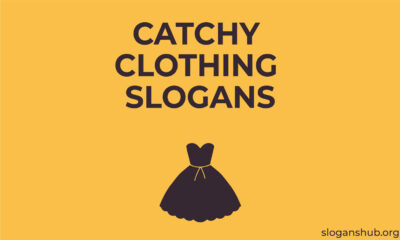Business Slogans
7 Common Mistakes to Avoid in Slogan Writing
A slogan is more than just a catchy phrase; it is the essence of your brand distilled into a few memorable words. In this article, we will explore the common mistakes to avoid in slogan writing and provide expert tips to help you craft memorable and effective slogans.
A well-crafted slogan can significantly impact your brand, creating lasting impressions and forging strong connections with your audience.
However, many beginners in the slogan-writing process fall into common traps that can undermine their efforts.
Understanding the Role of a Slogan
A slogan is a brief and memorable phrase that captures the importance of a brand or product. It serves as a quick identifier, a reminder of what the brand stands for, and a reminder of why this brand is trusted. Effective slogans can evoke emotions, convey value propositions, and enhance brand recall.
For example, Nike’s “Just Do It” inspires action and determination, while Apple’s “Think Different” underscores innovation and uniqueness.
The psychology behind effective slogans lies in their ability to connect emotionally with the audience, creating a sense of belonging or aspiration.
A well-crafted slogan can differentiate a brand in a crowded market, making it more recognizable and relatable.
You might be interested in How to Come Up with a Catchy Business Name 20 Easy Steps
Common Mistakes in Slogan Writing
Lack of Clarity
One of the most significant mistakes in slogan writing is the lack of clarity. A vague or ambiguous slogan needs to communicate the brand’s message effectively. For example, a slogan like “We Care” is too generic and can be associated with any company.
Tips for Ensuring Clarity:
- Be specific about what your brand offers.
- Use clear and concise language.
- Avoid jargon and complex words.
Being Too Complex
Complex slogans take time to remember and understand. A slogan should be simple enough to stick in the minds of your audience. An example of an overly complex slogan could be “Innovating comprehensive solutions for a better tomorrow.”
Tips for Simplicity and Brevity:
- Keep your slogan short and sweet, ideally under six words.
- Focus on one key message or idea.
- Use simple, everyday language.
Overused Clichés
Using clichés can make your slogan sound unoriginal and uninspiring. Phrases like “Your trusted partner” or “Quality you can count on” are overused and fail to stand out.
Tips for Originality and Creativity:
- Brainstorm unique phrases that reflect your brand’s unique value.
- Avoid phrases that are commonly used in your industry.
- Consider using wordplay or puns, but ensure they fit your brand tone.
Lack of Connection with the Target Audience
A slogan that doesn’t resonate with your target audience is ineffective. For instance, a highly technical slogan for a consumer-focused product may alienate potential customers.
Tips for Audience Research and Relevance:
- Conduct market research to understand your audience’s preferences and pain points.
- Tailor your slogan to address your target market’s specific needs and desires.
- Use language and references that are familiar and relatable to your audience.
Forgetting the Brand Identity
A slogan that doesn’t align with your brand’s identity can confuse customers. For example, a playful and casual slogan for a luxury brand would be mismatched.
Tips for Aligning Slogans with Brand Values and Identity:
- Reflect on your brand’s mission, vision, and values in your slogan.
- Ensure consistency in tone and style with other brand elements.
- Consider what makes your brand unique and how to convey that in your slogan.
Ignoring Emotional Appeal
Slogans that fail to evoke any emotion are less likely to be remembered. A purely factual slogan, such as “We manufacture electronics” lacks the emotional pull to engage the audience.
Tips for Incorporating Emotional Triggers:
- Identify the core emotions you want your audience to feel (e.g., joy, trust, excitement).
- Use words that evoke these emotions.
- Craft a narrative or story around your slogan that taps into these feelings.
Not Being Memorable
A forgettable slogan fails to serve its purpose. If your audience can’t remember your slogan, it won’t help build brand recall. Too long, complex, or generic slogans tend to be easily forgotten.
Tips for Creating Memorable and Catchy Slogans:
- Use rhythmic or rhyming words.
- Keep it short and punchy.
- Incorporate a unique twist or a surprising element.
Best Practices for Writing Effective Slogans
Before writing your slogan, conduct thorough research. Understand your brand, market, and competitors. Brainstorm ideas with your team using techniques such as mind mapping, word association, and free writing.
Testing Slogans with Focus Groups or Surveys
Test your slogan ideas with focus groups or through surveys. Gather feedback on clarity, emotional impact, and memorability. This feedback can be invaluable in refining your slogan.
Iterating Based on Feedback
Use the feedback to tweak and improve your slogan. Sometimes, small changes can make a big difference. Continue refining until you have a slogan that resonates well with your audience.
Case Studies of Successful Slogans
Nike: “Just Do It”
Nike’s slogan is a masterclass in simplicity and emotional appeal. It inspires action and reflects the brand’s identity, which is focused on athletic excellence and determination.
Apple: “Think Different”
Apple’s slogan emphasizes innovation and creativity. It aligns perfectly with the brand’s mission to challenge the status quo and push the boundaries of technology.
McDonald’s: “I’m Lovin’ It”
This slogan is memorable due to its simplicity and emotional connection. It evokes positive feelings and reflects the brand’s focus on customer enjoyment and satisfaction.
Check out this detailed guide on How to Write a Slogan for Your School
Tools and Resources for Slogan Writing
Online Slogan Generators
Tools like Slogan Generator, Shopify’s Slogan Maker, and Oberlo’s Slogan Generator can help inspire ideas.
Books on Branding and Advertising
- “Made to Stick” by Chip Heath and Dan Heath
- “Building a StoryBrand” by Donald Miller
Workshops and Courses
Consider enrolling in workshops and courses focused on branding and advertising. Platforms like Coursera, Udemy, and LinkedIn Learning offer various courses that can enhance your slogan-writing skills.
Final Thoughts
Creating an effective slogan is both an art and a science. You can create impactful and memorable slogans while focusing on these Common Mistakes to Avoid in Slogan Writing: lack of clarity, complexity, clichés, disconnection from the target audience, misalignment with brand identity, lack of emotional appeal, and forgettability.
Remember to research, brainstorm, test, and iterate to refine your slogan. With the right approach, your slogan can become a powerful tool in your branding arsenal, leaving a lasting impression on your audience.
Frequently Asked Questions
How long should a slogan be?
Ideally, a slogan should be under six words. Shorter slogans are easier to remember.
How often should we change our slogan?
Change your slogan only when there’s a significant shift in your brand strategy or market positioning. Frequent changes can confuse your audience.
What to Avoid When Making a Slogan?
- Avoid being too vague or ambiguous.
- Steer clear of overly complex language and ideas.
- Avoid clichés and generic phrases.
- Don’t disconnect from your target audience.
- Ensure your slogan aligns with your brand identity.
- Avoid lack of emotional appeal.
- Ensure the slogan is memorable and not forgettable.
What are 5 Key Strategies to Make a Good Slogan?
If you already know the common mistakes to avoid in slogan writing then you just need to follow these 5 Key Strategies to Make a Good Slogan.
- Simplicity: Keep it short and easy to remember.
- Clarity: Make sure it clearly communicates your brand message.
- Emotional Appeal: Use words that evoke emotions.
- Uniqueness: Ensure it stands out from competitors.
- Relevance: Tailor it to resonate with your target audience.
What Makes a Slogan Ineffective?
- Lack of clarity or being too vague.
- Overly complex language that is hard to remember.
- Use of clichés that make it sound unoriginal.
- Disconnection from the target audience’s interests and needs.
- Misalignment with the brand’s identity and values.
- Absence of emotional appeal.
- Forgettability due to lack of distinctiveness.
What Could Go Wrong with a Slogan?
If you know the common mistakes to avoid in slogan writing, then check out these practical examples of what you might face if you make the mistakes.
- Miscommunication of the brand’s message.
- Negative connotations or misunderstandings.
- Cultural insensitivity or offensiveness.
- Legal issues with trademark infringements.
- Confusion with competitor slogans.
- Inability to resonate with the target audience.
What are Some Bad Slogans?
- Pepsi:
“Come alive with the Pepsi Generation” (Misinterpreted in China as “Pepsi brings your ancestors back from the dead”). - Ford:
“Every car has a high-quality body” (Misunderstood in Belgium as “Every car has a high-quality corpse”). - KFC:
“Finger-lickin’ good” (Misinterpreted in China as “Eat your fingers off”). - Coors:
“Turn it loose” (Misunderstood in Spanish as “Suffer from diarrhea”). - Electrolux:
“Nothing sucks like an Electrolux” (Poor translation choice for English-speaking markets).
Related Articles:
- Catchy Campaign Slogans for Student Council Elections
- Funny Campaign Slogans for Student Council Elections
- Catchy Campaign Slogans for Student Council
- Best School Board Campaign Slogans and Catchy Ideas
- Catchy School Election Campaign Slogans and Taglines
- Catchy High School Campaign Slogans & Creative Ideas
- Best Slogans on Girl Education
- Catchy Slogans On the Importance Of Education & Taglines
- Best School Spirit Slogans And Great Taglines

-

 Business Slogans2 years ago
Business Slogans2 years ago199 Catchy Clothing Slogans Ideas, Clothing Taglines for Business
-

 Business Slogans2 years ago
Business Slogans2 years ago111 Catchy Fashion Slogan Ideas & Fashion Taglines 2024
-

 Business Slogans2 years ago
Business Slogans2 years ago150 Good Anti Drug Slogans to Spread Awareness Agains Drugs
-

 Business Slogans2 years ago
Business Slogans2 years ago300 Holistic Health Slogans | Best Health Taglines & Health Phrase